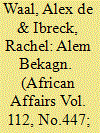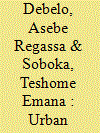|
|
|
Sort Order |
|
|
|
Items / Page
|
|
|
|
|
|
|
| Srl | Item |
| 1 |
ID:
119116


|
|
|
|
|
| Publication |
2013.
|
| Summary/Abstract |
The African Union's new offices in Addis Ababa stand upon the site of the city's former central prison, known as Alem Bekagn, where thousands of people suffered and died. This article traces the history of the prison and examines efforts to create a memorial at the site. These initiatives illustrate the African Union (AU) in transition. They echo AU commitments to act against atrocities and in support of rights and justice and suggest a distinct vision of pan-African community and a corresponding institutional culture. But, much like the AU itself, the meaning of the planned memorial is ambivalent and contested. The fact that the AU bulldozed Ethiopia's most notorious prison in order to establish its new offices and a conference hall is richly symbolic of 'buried memory' - the tendency of post-colonial elites to suppress the memory of victims of state violence while celebrating chosen heroes. The AU still venerates leaders and is quiet about current violations, but the organization's promise and process to remember the ordinary victims of state violence indicate a political opening and may contribute a novel space for the recounting of human rights abuses.
|
|
|
|
|
|
|
|
|
|
|
|
|
|
|
|
| 2 |
ID:
166361


|
|
|
|
|
| Summary/Abstract |
This study evaluates the distribution of electricity subsidies to residential customers in Addis Ababa, Ethiopia in 2016 that results from the current increasing block tariff (IBT) structure. Customer billing data supplied by the electricity utility were matched with socioeconomic information collected from a survey of 987 households, and used with a utility-specific estimate of the costs of electricity service to estimate household-specific subsidies. The analysis differentiates between primary customers, who own an electricity account, and nonprimary customers, who pay a primary account holder, and presents the first detailed analysis of the incidence of subsidies provided to households with private versus shared electricity connections. Results show that households in the poorest quintile received 7% of the total subsidy, while households in the wealthiest quintile received 37%. The majority of households with shared connections were in poorer quintiles, and 80% in the poorest quintile were nonprimary customers. The regressive outcomes of the IBT structure are explained by two of its attributes: (1) the volumetric rates in all tariff blocks are substantially below the total average cost of delivery of the service; and (2) there is only a moderate association between electricity consumption and household wealth.
|
|
|
|
|
|
|
|
|
|
|
|
|
|
|
|
| 3 |
ID:
151621


|
|
|
|
|
| Summary/Abstract |
This article presents a spatial approach to the recent history of conflict and confrontation between the Ethiopian Government and Ethiopian Muslim Communities in Addis Ababa. Based on original ethnographic data and inspired by existing academic studies on political-religious relationships in Addis Ababa, this study takes a closer look at the significance of the urban public landscape in power-struggles between the EPRDF and the Muslim communities. The article argues that political-religious struggle in Addis Ababa shapes the current urban landscape, as use of and control over urban public space and place forms a crucial element in the strategies of public authority of all involved actors.
|
|
|
|
|
|
|
|
|
|
|
|
|
|
|
|
| 4 |
ID:
110982


|
|
|
|
|
| Publication |
2012.
|
| Summary/Abstract |
Sudan and South Sudan signed a non-aggression treaty in the Ethiopian capital Addis Ababa on 10 February, which African Union (AU) mediators hope will calm growing tensions between the two countries. Thabo Mbeki, the former president of South Africa and chief African Union mediator, told reporters both sides had agreed to respect the sovereignty and territorial integrity of the other. He was speaking after the first meeting between Sudan and South Sudan in a new round of talks aimed at addressing the numerous post-secession issues that have thus far eluded agreement, contributing to increasingly belligerent rhetoric from both sides. Underpinning the treaty, a new monitoring mechanism was created to investigate any allegations of violations by either side. However, it is unclear how this will be implemented in the remote border areas where most confrontations to date have occurred.
|
|
|
|
|
|
|
|
|
|
|
|
|
|
|
|
| 5 |
ID:
193196


|
|
|
|
|
| Summary/Abstract |
Frontier making in Ethiopia has historical roots from the formation of the modern Ethiopian state in the late-19th century through wars of conquest. The conquest, which was inspired by political and economic motivations of the highland Christian kingdom, used the notion of a “civilizing mission”—civilizing the “backward” and “underdeveloped” people, and “underutilized” spaces—through imposition of an imperial state system and Orthodox Christianity. The foundation and horizontal expansion of Addis Ababa or Finfinne by displacing Indigenous inhabitants was part of the state building project under successive regimes. Over the last century and a half, the city has continued its unchecked expansion in a process involving multilayered actors whose interests overlapped in terms of grabbing the land they considered “underutilized.” More specifically, the last three decades evince commoditization of farmlands, grazing areas, and cultural and sacred spaces through land lease, which eventually dissolve existing customary systems, values, and practices. This paper critically analyzes the dynamics of frontier making in or from Addis Ababa or Finfinne, the political economy behind such unchecked frontier expansion and how it activated the power of resistance in 2014. The paper concludes that frontier making in or from Addis Ababa through dispossession of Oromo farmers has been part of the broader political establishment in Ethiopia and should be viewed within the same lens.
|
|
|
|
|
|
|
|
|
|
|
|
|
|
|
|
|
|
|
|
|